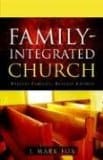 One of the current buzzwords in churchlife today is the phrase, “family-integrated.” However, what looks to the casual observer as simply a “fad” is more than that: it is a theological, methodological, and philosophical conviction for those leaders in churches who are truly family-integrated.
One of the current buzzwords in churchlife today is the phrase, “family-integrated.” However, what looks to the casual observer as simply a “fad” is more than that: it is a theological, methodological, and philosophical conviction for those leaders in churches who are truly family-integrated.
Family-Integrated Church, by J. Mark Fox, (Xulon, 2006) is one church’s story of how it transformed over the years from a typical program-driven church to one that became purely family-driven. It is the story of how Antioch Community Church in Burlington, North Carolina has developed into what it is today.
Fox says, “We realized…how God had led us over the past 18 years to be a church where biblical manhood and womanhood is celebrated and encouraged, and families are not divided up as soon as they walk in the door.” (10)
With this statement, Fox opens the discussion on the topic of age-segregation versus integration. To be honest, up until a year or so ago I had given very little thought to the truth that there was another way to “do church” where people and children of different ages were not divided up into age-graded classes and/or ministries.
Early in Antioch’s history, the church met at Elon College where hundreds of college students attended their weekly services. Fox says, “We could not be a program-driven church while we were meeting on the campus, and did not have a facility to ‘call our own’…we did not have the space or energy to devote to age-segregated programs. So we did not have them.”
What started out as a void in the church developed into one of its key principles. Fox says, “It was becoming clearer to us as we grew up in the Lord that God was changing the vision of the church. We had started with the idea that we could be all things to all people…but God began to change our hearts. We began to see that the heart of the church was family, that God had called us to relate to one another as brothers and sisters.” (44) Furthermore, “We began to catch on to the revelation that God’s purpose for “youth ministry” is to turn the hearts of the fathers to their children and the hearts of children to their fathers” and not the opposite. (45) This idea is central to the family-integrated movement.
In Antioch’s children’s ministry, the church started to run out of called, qualified teachers. Instead of plugging reluctant people into those slots the church began to re-think their strategy. Part of this strategy included ditching Sunday School. Fox says, “But why was Sunday School begun in the first place? It was an effort to reach out to the poor children who were not well educated, who were running wild in the streets on the ‘Sabbath’ and profaning the day of the Lord. It was an effort at evangelism and education, and I believe God used the effort to win souls and encourage saints to reach out. But as with many programs that started out with good intentions, the purpose morphed into a place to corral young people and children so they could be kept out of trouble and possibly where they could be taught the Bible stories that every child should know.” (55)
Fox states further, “…most churches who offer age-segregated programs do so because they believe that is ‘normal Christianity,’ not because they believe it is the best way to reach children. They keep Sunday School and other programs in place because they honestly believe that a church without a Sunday School program is not even a biblical church. But I would challenge them to find anything that vaguely resembles age-segregation in the Scripture.” (55) To a children’s pastor that oversees a very high-octane program-driven ministry, that one stung.
Antioch does offer programs during the “Sunday School hour” before church and at other times on a rotation basis. The key is that no program is permanent. They use programs as they see fit and discard them when they’ve run their course.
The second half of the book is a more of a description of the way the church is governed and organized and less about the family-integrated element. However, the last chapter does give a sketch at what it looks like on a typical Sunday morning.
Most Sundays begin at 7:30 am as the pastor and elders pray for 90 minutes. That’s humbling. At 9:00 am the worship team gathers and practices and any current studies that are going on may meet during this time. They’ve had a class before for boys aged 12-18 where fathers come and are involved. They’ve also had one for girls of the same age. Again, any idea for a short-term class can be done during that hour.
At 10:00 am the worship service begins. For the first 3o minutes of the service, during the singing, there is no nursery. Antioch desires to have infants in the sanctuary, crying and all, during corporate worship. Once the preaching starts, the nursery is open to those children 2 years old and younger, although Antioch encourages them to stay with their families. Another interesting aspect is that after the sermon, the pastor opens up the floor (egads!) for questions and testimony by the members. Fox says that this is is almost always a rewarding time. Whenever someone abuses it, however, the elders, call the abusers out. Once a month the church takes communion after this session. Then they open the floor once again to “thanksgivings” and people tell how the Lord has been good to them. The entire service usually runs around 2 hours.
I would say that Family-Integrated Church is a must read for anyone that is involved in children’s ministry or any type of church ministry for that matter. Some will be tempted to immediately overhaul their ministry or church by reading this book. That, of course, would be disastrous. However, there are many subtle things that you could do in an established church that can help create a more family-integrated atmosphere. Antioch Community Church is just one of many such churches being plante or organized. Family-integration is not a fad. It is a conviction. And it is one that will further continue to impact, and rightly so, churches, ministries, and lives.
More posts about family ministry: Read Terry Dealaney’s review of the book Three Perspectives on Family Ministry or browse all our posts on family ministry.
